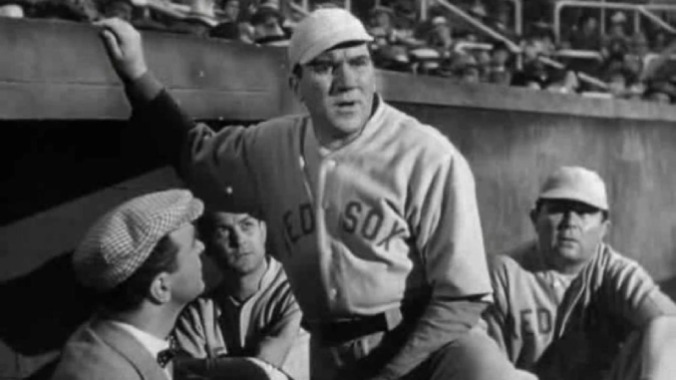The Babe Ruth Story: The Worst Biopic Ever Made

Nobody expects biopics to be great. Sure, there are exceptions to the rule, but whenever we see the release of yet another glossy biographical drama on the horizon, a slick production that promises a carefully curated glimpse into the life of a well-known individual, we know exactly what to expect. The formula of the biopic is so familiar, so well-worn and risk-averse, that you could set your watch to it: The sad childhood, the rise to the top, the drug/alcohol/money problems, the sad but supportive spouse watching from the sidelines (who’s almost always a woman because these films prize male genius) and a triumphant comeback that ends the story early enough to avoid fewer cinematic troubles.
It’s boring and thoroughly, proudly middlebrow, but you don’t fuck with the formula for a reason. Biopics make money, win awards and ensure that the central figure’s legacy (and profitable estate) lives on for a few more years. Audiences seem to prefer this curated version of history over the hard and messy truths. Hey, if we wanted the real story, that’s what the documentaries are for, right? Even the least discerning viewers, however, have their limits. There’s only so much historical whitewashing one can stomach before rejecting the semi-truths as outright lies. The limit can be hard to define. Queen fans seemed generally okay with Bohemian Rhapsody changing the timeline of Freddie Mercury’s AIDS diagnosis, while Cole Porter devotees revolted at De-Lovely downplaying his sexuality. But it’s unlikely that even the most zealous fandoms would be all-in on something like The Babe Ruth Story, one of the worst biopics ever made.
George Herman “Babe” Ruth remains one of the true legends of baseball, a player so iconic that he remains one of its towering figures. Even people who don’t know anything about baseball know who Babe Ruth is, even if it’s only for the candy bar named after him. He certainly lived a life worthy of a fascinating biopic, and a few have been made over the decades hoping to capture some of his unique magic. The first one is easily the worst, the kind of biopic that feels like a prequel to Walk Hard or an extended joke about the ways that American culture canonizes celebrities.
Released in 1948 and directed by Roy Del Ruth (no relation), The Babe Ruth Story was originally supposed to star Babe as himself, but by that point in time, his ill health had made it impossible. Instead, Oscar nominee William Bendix was hired. He plays the role of Babe from the age of 18 onward. At the time of the film’s release, he was 42, and he doesn’t look a day over 56 in the movie. Bendix’s strategy for playing Ruth as a young man was to talk like an especially stupid toddler, a choice he maintains even as Babe ages into his late 30s. Indeed, the entire film seems to view Babe Ruth as a by-golly, gee-willikers naïve child, and it wears thin very quickly.
-

-

-

-

-

-

-

-

-

-

-

-

-

-

-

-

-

-

-

-

-

-

-

-

-

-

-

-

-

-

-

-

-

-

-

-

-

-

-

-








































